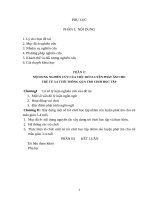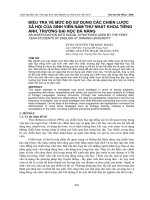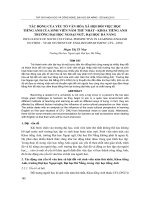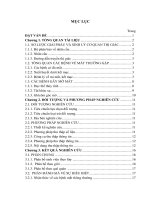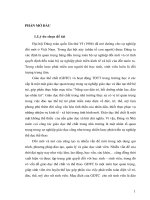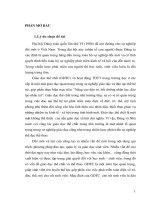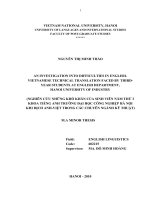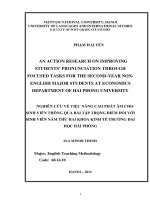Nghiên cứu về việc nâng cao phát âm cho sinh viên thông qua bài tập trọng điểm đối với sinh viên năm thứ hai khoa Kinh tế trường Đại học Hải Phòng
Bạn đang xem bản rút gọn của tài liệu. Xem và tải ngay bản đầy đủ của tài liệu tại đây (4.49 MB, 115 trang )
1
VIETNAM NATIONAL UNIVERSITY, HANOI
UNIVERSITY OF LANGUAGES AND INTERNATIONAL STUDIES
FACULTY OF POST-GRADUATE STUDIES
PHẠM HẢI YẾN
AN ACTION RESEARCH ON IMPROVING
STUDENTS’ PRONUNCIATION THROUGH
FOCUSED TASKS FOR THE SECOND-YEAR NON-
ENGLISH MAJOR STUDENTS AT ECONOMICS
DEPARTMENT OF HAI PHONG UNIVERSITY
NGHIÊN CỨU VỀ VIỆC NÂNG CAO PHÁT ÂM CHO
SINH VIÊN THÔNG QUA BÀI TẬP TRỌNG ĐIỂM ĐỐI VỚI
SINH VIÊN NĂM THỨ HAI KHOA KINH TẾ TRƯỜNG ĐẠI
HỌC HẢI PHÒNG
M.A MINOR THESIS
Major: English Teaching Methodology
Code: 60.14.10
HANOI – 2012
v
TABLE OF CONTENTS
Page
ACKNOWLEDGEMENT i
ABSTRACT ii
LIST OF TABLES AND FIGURES iii
PART A: INTRODUCTION
Rationale………………………………………………………… 1
Statement of the problem……………………………………… 2
3. Purposes of the study 3
4. Research questions .4
5. Scope of the study………………………… 4
6. Research method 4
7. Significance of the study………………………………………… ………… 4
8. Design of the study…………………………………………………………… 5
PART B: DEVELOPMENT
CHAPTER I: LITERATURE REVIEW
1. Overview of approaches and methods in pronunciation teaching 6
1.1 Overview of approaches in pronunciation teaching 6
1.2 Overview of methods in pronunciation teaching 7
2. Overview of tasks 8
2.1. Task definition …………………………………………………… 8
2.2 Task type …………………………………………………………………… 10
2.3 Task components…………………………………………………………… 12
3. Task-based language teaching … 13
3.1 Definition of task-based language teaching………………….….………… 13
3.2 The framework of task-based language teaching…………………………… 15
3.3 Principles for task-based language teaching………………………………….16
4. Related studies …17
vi
CHAPTER II: METHODOLOGY
1. Argument for the use of focused tasks to improve second year students’
English pronunciation .19
2. Rationale for the use of an action research 26
3. Background of the study .29
3.1 Participants……………………………………………………………………29
3.2 The English and pronunciation program………………………………… 30
4. Instruments .31
5. Intervention .34
6. Research program .34
7. Procedures…………………………………………………………………… 36
CHAPTER III: FINDINGS
1. Students’ problems in English sound pronunciation 37
1.1 Students’ problems with English vowels 37
1.2 Students’ problems with English consonants 41
1.3 Students’ problems with English sounds in “ed” and “s/es” endings……… 47
2. Possible reasons for the students’ weak pronunciation competence 49
2.1 The teachers’ and students’ awareness of and attitude on English pronunciation
and students’ problems in English pronunciation 49
2.2 Students’ ability on English pronunciation 53
2.3 Students’ pronunciation learning at secondary schools and during the previous
years of the university .55
2.4 Other reasons………………………………… …………………………….57
3. Comparison of the students’ pronunciation performance in the pretest and the
posttest……………………………………………… ………………… …… 58
4. The students’ participation in other English courses during the time between
the pretest and the posttest 61
5. The students’ attitude and their justification of the focused tasks on
pronunciation given in the research 61
CHAPTER IV: DISCUSSION AND IMPLICATION
vii
1. Discussion of research questions 63
2. Pedagogical implication 70
PART C: CONCLUSION
1. Conclusions 74
2. Limitations of the study 75
3. Suggestion for further study 76
REFERENCES 78
APPENDICES. I
1
PART A: INTRODUCTION
1. Rationale
English has been playing a more and more important role in the trend of
globalization in every field all over the world. Good English grammar knowledge,
reading and writing skills are not enough to meet the demand of the new conditions
any more. New life requires us the ability to communicate directly in real-life
situations. This means that it is necessary for us, especially our students, the owners
of the future, to be skillful in English speaking and listening. To achieve this, good
pronunciation is a factor, which can’t be lack of, because weak English
pronunciation results in low effect of English speaking and many difficulties in
English listening.
However, in my experience as a teacher of English for three years, English
pronunciation has not paid enough attention to by many second year non-English
majored students at Hai Phong University. Many pronunciation errors have been
made by the students here. This can be recognized in their speaking in every normal
English period or their English speaking final tests in previous 2 years or partly in
bad results in listening tests recently. Thus, dealing with the students’ problem of
pronunciation is very necessary and urgent. This is the responsibility of the students
themselves and their teachers as well. As a teacher of Hai Phong University, I have
taken much notice of what can be used to improve the students’ English
pronunciation.
In the communicative language teaching approach, tasks are widely used to
improve many students’ language skills such as listening, speaking, reading and
writing In my opinion, focused tasks, which have become more and more familiar
with both students and teachers nowadays, may be useful to help improve
pronunciation because of their advantages to students. According to the web
Wikipedia, the free encyclopedia, Communicative tasks have Task-based learning is
advantageous to the student because it is more student-centered, allows for more
meaningful communication, and often provides for practical extra-linguistic skill
building. As the tasks are likely to be familiar to the students (eg: visiting the
2
doctor), students are more likely to be engaged, which may further motivate them in
their language learning.
Additionally, tasks promote language acquisition through the types of
language and interaction they require. Although the teacher may present language in
the pre-task, the students are ultimately free to use what grammar constructs and
vocabulary they want. This allows them to use all the language they know and are
learning, rather than just the 'target language' of the lesson. On the other hand, tasks
can also be designed to make certain target forms 'task-essential,' thus making it
communicatively necessary for students to practice using them. In terms of
interaction, information gap tasks in particular have been shown to promote
negotiation of meaning and output modification.
The need of improving the students’ English pronunciation at Hai Phong
University and the advantages of using tasks in language teaching motivated me to
do the research on: “An action research on improving students’ pronunciation
through focused tasks for the second-year non-English major students at Economics
Department of Haiphong University”.
2. Statement of the problem
The detailed current situation of teaching pronunciation at Economic
Department, HaiPhong University will be analyzed in the next chapter. In this part,
we only look through the major characteristic of the statement of the problem.
As a teachers at English Department of Haiphong university, I have realized
that Vietnamese students in general and economic students in Haiphong university
in particular have a lot of problems concerning their pronunciation though there
have been much innovation in teaching and learning English in their secondary and
high schools.
Thanks to the reformations in education system at secondary and high
schools for the recent years, Vietnamese students now have chances to learn English
in all four skills – reading, listening, speaking and writing – rather than only reading
and grammar as it used to be in the past. However, a great number of students who
even become university students still cannot listen or speak English well. For
example, most of the students in HaiPhong University failed in listening Toeic test
3
in the grading exams at the beginning of school year in 2012. Another example is
the fact that, many students having good knowledge of English but their speaking is
not understandable in class when they answer teachers’ questions though they can
write the answers correctly. The main reason for these problems lies in their bad
pronunciation.
Another fact is that many non English major students graduated from
University also have the same problems. They cannot listen and speak well in their
job. I myself met a very young bank teller at a big bank in Hai Phong who was very
embarrassed and failed in a conversation with a foreign guest in a simple situation
in his job. The guest could not understand his speaking and finally the teller wrote
his words on a paper, and the information exchange was carried out on paper. It is
undeniable that, the failure in communication in this case was not the knowledge
but the pronunciation problems. In fact, we can meet many similar cases in work
environment everywhere, in which the people in non English major fields cannot
use English in communication in spite of many years of learning English. This
means that the pronunciation was not improved during the long time of learning
English at secondary, high schools and Universities.
From some above examples, it seems to us that students’ pronunciation has
not been concerned enough in either schools or universities and pronunciation
teaching and learning English pronunciation there still meets many problems
leading to the low effectiveness in this work. With the wonders about the statement
of the problems, the writer decided to research on it.
3. Purposes of the study
This research was designed to improve the students’ pronunciation
performance by using focused tasks. Generally, it has three purposes:
- To investigate a number of common English pronunciation problems faced by
second year non-English majored students at Hai Phong university. However, due to
the limitation of time, the research only focused on a number of English sounds.
- To find possible reasons for the weak English pronunciation ability of the
students.
- To justify the effect of using focused tasks on the students’ English pronunciation.
4
4. Research questions
With the above purposes, the research is conducted to answer the following
questions:
1. What are the students’ most common problems regarding some English sounds?
2. What are the possible reasons for the students’ weak pronunciation of English?
3. How can focused tasks improve students’ English pronunciation?
5. Scope of the study
The research was conducted on the second year non-English majored
students at Economics department of Hai Phong University. Regarding its scope,
the research was only aimed at justifying the effect of focused tasks on the students’
pronunciation of English sounds. Other aspects of English pronunciation would not
be investigated. Even though the researcher use speaking tests as an important
instrument for the research, only issues concerning the students’ pronunciation of
English sounds were taken into consideration.
6. Research method
The method used in this study is action research, with the use of some
instruments such as observation, questionnaires, speaking test and interviews.
Action research was chosen for the study because the aim of the study was
improving the students’ pronunciation within a certain context. The combination of
different instruments in the research would help to get reliable data and help the
researcher have a good investigation into the problems that the students were
having.
7. Significance of the study
The study can be much beneficial to English teachers, students and
researchers.
Firstly, English teachers, especially those who have never had enough
attention to their students’ English pronunciation and how to improve it, will have
some new experiences on this problems and a new look at the methodology of
pronunciation teaching- using focused tasks. The study hopes to be a sample or
suggestion for them to develop focused tasks in pronunciation lessons and other
English skill lessons as well. Furthermore, the limitation of this research and
5
problems during the application of focused tasks in teaching pronunciation will be
valuable for English teachers so that they can conduct Task- based English period
more smoothly and successfully.
Secondly, for students, the new method is expected to bring a lively and
interesting environment for their pronunciation lessons in which they can benefit
directly. Students can experience a new way of learning pronunciation and have
more inspiration with pronunciation. Besides, they can also get some good
experiences for their self- studying to improve their English pronunciation.
Finally, for the researchers, the study can provide useful information for
further studies of the same topic in the future.
Briefly, English teachers, students and researchers can benefit from the
results of this research.
8. Design of the study
The study consists of three parts:
Part A - Introduction - presents an overview of the study in which the
rationale for the research, the research statements, the purposes, the research
questions, the scope of the study, the research method, the significance of the study
and the design of the study were briefly presented.
Part B – Development: Chapter I - Literature review - reviews the
background theory relevant to the study, including the definition of focused tasks. It
also presents a number of researches in which techniques or tasks have been used to
help students make improvement in their language study. Chapter II - Methodology
– is a detailed discussion of the method used in the study including justification for
the use of focused tasks and action research. It also gives the description of research
components such as participants, contexts, research instruments…, as well as
research program. Chapter III – Findings – shows the findings of the research which
express the effectiveness of the study. Chapter IV – Discussions and implications –
discusses the findings of the research, gives implications.
Part C: - Conclusion- presents the conclusions, limitations of the research.
Besides, this part makes recommendations for further research in the same field.
6
PART B: DEVELOPMENT
CHAPTER I: LITERATURE REVIEW
1. Overview of approaches and methods in pronunciation teaching
1.1 Overview of approaches in pronunciation teaching
According to Celce-Murcia., et al, (1996, p.2)in Teaching Pronunciation,
there are two general approaches to the teaching of pronunciation in the modem
times, namely intuitive- imitative approach and analytic-linguistic approach.
An intuitive-imitative approach depends on “the learners’ ability to listen to
and imitate the rhythms and sounds of the target language without the intervention
of any explicit information.” This means the teaching of pronunciation depends
largely on the teacher’s turning on and rewinding a cassette player (or any other
instrument), and the main activities in the class are listening and repeating. Of
course, in order to do this, there must be the supply of authentic materials as well as
recording devices to use during the lesson. The teacher has no responsibility to
explain how sounds are formed or produced. Learners do their main task of
listening and imitating, and it is expected that they will gradually gain pronunciation
competence.
An analytic-linguistic approach “utilizes information and tools such as a
phonetic alphabet, articulatory descriptions, charts of the vocal apparatus and other
aids to supplement listening, imitation, and production.” In this approach, learners
are given explanation as well as training on how to form particular sounds of the
target language. This approach is actually a further development of the first
approach rather than to replace it because is still makes great use of authentic
materials, as well as listening and imitating phases during the lessons.
Today, the dominant teaching approach has been the Communicative
Approach Under this approach, the main objective of language is communication.
Therefore, students are not required to have a native-like pronunciation, but
intelligible one. This is a kind of “accepted pronunciation”, which means students
may make some mistakes provided those mistakes do not affect negatively on the
comprehension of the listeners or cause misunderstanding.
7
1.2 Overview of methods in pronunciation teaching
Regarding methods of language teaching in general and their philosophy of
pronunciation teaching in particular, it can be seen clearly that each method puts a
different weight on pronunciation, and therefore, treats pronunciation differently,
according to Tran (2008).
Some methods, such as Grammar Translation or Reading-based approaches,
give no acknowledge to pronunciation. The teacher use learners’ native language to
teach grammar or text comprehension. Thus, little attention is given to speaking,
and almost none to pronunciation.
However, most methods give a genuine concern for the teaching of
pronunciation. The appearance of a method often brings about new approaches
towards the teaching of particular issues, most of which are affected by the time
they come into being.
In Direct Method, which first became popular in the late 1800s and early
1900s, the teacher provides learners with a model for native-like speech. This can
either be the teacher himself or a recording. By listening and then imitating the
model excessively, learners gradually develop their pronunciation. Some successors
to this method are called naturalistic methods, which mean methods that devote a
period of learning solely to listening before speaking is allowed. Linguists
following this method believe that when learners are asked to listen without having
to worry about speaking, they are better at recognizing the sounds because they are
under less pressure. Thus, it is likely that they will be able to produce correct sounds
even without receiving explicit pronunciation instruction.
Other methods, namely Audiolingualism in the US and the Oral Approach in
Britain during the 1940s and 1950s have another way to treat pronunciation. In the
class, pronunciation is very important and is taught explicitly from the start. The
teacher (or a recording) models a sound, or an utterance and students are asked to
repeat it. The difference between Audiolingualism and Direct Method lies in the
feature that in Audiolingualism class, beside the model, the teacher also takes
advantage of a number of teaching aids such as phonetic description, or the
transcription system. The most common technique that is used to teach
8
pronunciation is the minimal pair drills. Learners are asked to distinguish between
two different sounds that might sound similar by listening to the teacher or a tape
recorder. This listening discrimination is followed by oral practice.
During the 1970s, the Silent Way came to public attention. In classes
applying this method, accurate pronunciation is a focus from the very beginning.
The teacher speaks as little as possible, but takes advantage of gestures to indicate
what the students should do. S/he can do this with the aid of a number of tools such
as a sound-colour chart, the Fidel charts, word charts, and colored rods.
Another method that also came into being during the 1970s was the
Community Language Learning (CLL). This is a method which focuses much on the
learners rather than the teacher or teaching curriculum A tape recorder is an
indispensable tool in this class. Students sit round ạ table, and then ask the teacher
to translate any utterances they wish to be able to speak in the target language. The
teacher then provides students with the phrase they need orally. After some time of
practicing its pronunciation, when students can produce the whole utterance
fluently, it is recorded on the tape. After that, the tape is played back and the
students are able to compare their pronunciation with the target one provided by the
teacher. It is the students who decide what particular utterances they would like to
be trained pronunciation. The teacher is regarded as a “computer” turning on and
off at the students’ request.
How can learners achieve good pronunciation? This can be done by the
appropriate choice or combination of methods and techniques in a way which suits
them.
2. Overview of tasks
To clarify the topic “improving students’ pronunciation through focused
tasks”, it should first make the phrase “focused tasks” clearer. The phrases “focused
tasks” in this study refers to the tasks which focus on certain problems of the
students’ pronunciation and aim at dealing with those problems. Therefore,
“focused tasks” means “tasks” in nature. Thus, this part will review some issues of
tasks.
2.1. Task definition
9
A review of literature reveals a wide range of definitions of task. Firstly,
according to Long (1985, p.89), a task is “a piece of work undertaken for oneself or
for others, freely or for some reward”. Thus, examples of tasks include painting a
fence, dressing a child, filling out a form, buying a pair of shoes, making an airline
reservation, borrowing a library book, taking a driving test, typing a letter, taking a
hotel reservation, writing a cheque, finding a street destination and helping someone
to cross a road. In other words, “task” is meant that the hundred and one things
people do in everyday life, at work, at play, and in between. It can be seen that this
is a non-linguistic definition. Actually, as Nunan (1989) comments, it is the sort of
characterization which might be offered by a learner, if asked why he is learning the
language.
Secondly, Richards, Platt and Weber (1985) gave another definition, task is
regarded as “an activity or action which is carried out as the result of processing or
understanding language” (Richard, Platt and Weber, 1985, p.289). For example,
drawing a map while listening to a tape, listening to an instruction and performing a
command, may be referred to, as tasks. Tasks may or may not involve the
production of language. The use of a variety of different kinds of tasks in language
teaching is said to I make language more communicative since it provides a purpose
for a classroom activity which goes beyond the practice of language for its own
sake. Here, in contrast with Long, the authors offer a pedagogical definition. In
other words, tasks are defined in terms of classroom undertakings.
Finally, according to Breen (1987), is “any structured language learning
endeavor which has a particular objective, appropriate content, a specified working
procedure, and a range of outcomes for those who undertake the task” (Breen, 1987,
p. 23) “Task” therefore assumed to refer to a range of work plans which have the
overall purpose of facilitating language learning - from the simple and brief exercise
type, to more complex and lengthy activities such as group problem-solving or
simulations and decision making.
All the authors share a common point of view on tasks which suggest that
tasks are concerned with communicative language use. In other words, they refer to
10
undertakings in which the learners comprehend, produce and interact in the target
language in the contexts in which they are focused on meaning rather than form.
2.2 Task type
When designing tasks for any language lesson, a teacher has a number of
choices to make in terms of the type of task. The classification of tasks can be
different depending on the perspectives of the linguists or researchers. Some
classifications are general and others are more specific. According to Willis (2006),
there are many ways to define types of tasks based on different aspects of task. For
example, Nunan (1989) suggests two big types of task: real-world tasks and
pedagogical tasks. Whereas, Willis (1996) lists six types of tasks of TBLT in her A
framework for task-based learning, which are: listing, ordering and sorting,
comparing, problem solving, sharing experience and creative tasks. From easy to
difficult, these six types of tasks all reveal the recognition process of students. The
tasks in TBLT should be “comparable to real life which might help students
accomplish the tasks and show their communicative competence in classroom
teaching and real life situations” (Willis, 1996, p. 149). Meanwhile, other people
can divide tasks according to types of topic, cognitive processes, language skills
required or the outcome of the task.
According to Nunan (1989), real-world tasks provide learners with chances to
use language in the world beyond the class while pedagogical tasks require students
to do things which unlikely happen in the real life. In fact, it is ideal if a teacher can
design suitable real-world tasks for his/her lesson. However, it is unusual for real-
world tasks not to be adapted so that they can be suitable with students’ level,
classroom conditions or syllabus. For example, a piece of news for high school
students might be re-recorded at a lower or played many times until they can catch
the information. In the real life, this is impossible. Therefore, in order to increase
learning opportunities in the classroom, Nunan (1989) thinks of the transformation
from real-world tasks into pedagogical tasks. Nevertheless, the distinction between
two types of task is not always clear. It is easy to distinguish a real-world task like
“the learner will listen to a weather forecast and decide whether or not to take an
11
umbrella and sweater at school” and a pedagogical one like “the leaner will listen to
an aural text and answer true or false questions”. However, as Nunan (1989)
mentions, there are tasks which are in principle authentic but seem not to happen in
the real life (for example, a speaking task for children, “Making a formal
introduction”). In the mean time, there are pedagogical tasks having real-life context
such as “listening to an aural text and write a sentence restating the gist”. Therefore,
it is possible to say that there is no clear criterion to differentiate real-life task and
pedagogical task.
In the meantime, there are six types of tasks listed by Willis (1996, p.149)
which relate to the recognition process of learners:
(1) Listing : Including brainstorming and fact-finding. The outcome of this
task is a completed list or draft mind-map. Listing tasks help train students’
comprehension and induction ability.
(2) Ordering, sorting: Including sequencing, ranking, categorizing and
classifying. The outcome of tasks is a set of information ordered and sorted
according to specific criteria. These types might foster comprehension, logic and
reasoning ability.
(3) Comparing: Including matching, finding similarities or differences. After
the completion of tasks, students will have the appropriately matched or assembled
items, or the identification of similarities and/or differences. This type of task could
enhance students’ ability of discretion.
(4) Problem-solving: Including analyzing real situation, analyzing
hypothetical situations, reasoning, and decision-making. The outcome might be
solutions to the problem. The tasks can help foster students’ reasoning and decision-
making ability.
(5) Sharing experience: Including narrating, describing, exploring and
explaining attitudes, opinions, and reactions. The outcome usually can be largely
social. This can help students to share and exchange their knowledge and
experience.
(6) Creative tasks: Including brainstorming, fact-finding, ordering and
sorting, comparing, problem-solving and many others. The outcome might be end
12
product which can be appreciated by a wider audience. Students can cultivate their
comprehensive ability of solving problems with their ability of reasoning, logical
and analyzing.
In this research, tasks which are designed to use in pronunciation lessons are
only pedagogical tasks according to the classification of Nunan (1989).
2.3 Task components
The introduction of task components given by Nunan (1989) will be the focus
of the current research. According to him, a task should include six components:
Figure 1. A framework for analyzing communicative tasks
Goals may be “a range of general outcomes (communicative, affective or
cognitive) or may directly describe teacher or learner behavior” (Nunan, 1989,
p.49). They can be stated clearly in each lesson or not and a task may have a variety
of goals.
“Input refers to the data that form the point of departure for the task” (Nunan,
1989, p.53). Input for communicative tasks comes from a number of sources and it
is not easy to count and classify all types of input. They may be authentic materials
like letters, newspaper, drawings, invoices, menus, etc. They may also be provided
by teachers or textbooks and even learners themselves. Input with or without
authenticity is totally not the big matter because the matter lies in the creation and
combination of input materials so that they can provide learners with optimal
learning opportunities.
Activities are what learners will actually do with the input during the task
implementation. According to the Bangalore Project (as cited in Nunan, 1989,
p.66), there are three principal activity types which are information gap, reasoning
Goal
Input
Activities
Teacher
Learner
Settings
TASK
13
gap and opinion gap. Moreover, activities can be divided into more detailed types
such as: questions and answers, dialogues and role-plays, matching activities,
communication strategies, pictures and picture stories, puzzles and problems,
discussions and decisions (Pattison, 1987).
Roles refer to the part that learners and teachers are expected to play in
carrying out learning tasks. Different approaches have different roles of learners and
teachers. In task-based learning and teaching, teachers are believed to perform two
main actions: motivating the learners and supporting them to perform task
(Branden, 2006). Learners have an active role and they should contribute to the
lesson as well as receive new knowledge (Nunan, 1989).
Settings are “the classroom arrangements specified or implied in the task, and
it also requires consideration of whether the task is to be carried out wholly or partly
outside the classroom” (Nunan, 1989, p.91). Referring to “settings”, it is necessary
to differentiate between “mode” and “environment”.
As introduced by Nunan (1989), “mode” is the way that the learner will take
actions in the task. It can be an individual or a group basis. “Environment” refers to
the location of the language learning process.
3. Task-based language teaching
3.1 Definition of task-based language teaching
For the past 20 years, task-based language teaching (TBLT) has drawn
attention of second language acquisition researchers, curriculum developers,
educationalists and teachers worldwide. While PPP is considered the methodology
used in the weak version of CLT, tasks has a dominant role in strong version of
CLT (Ellis, 1999). In another view, task-based teaching is regarded as a particular
realization of CLT. It is a teaching method in which tasks is the center and the aim
of task-based learning is to make language classroom approximate to the target
language environment, develop students’ ability to communicate.
Nunan (1999, p. 94) defines task-based language teaching as “an approach to
the design of language course in which the point of departure is not an ordered list
of linguistic items, but a collection of tasks”. In other words, in task-based language
teaching, tasks become the center of the course. Without emphasizing the
14
establishment of a task-based course, Richards and Rogers (2001, p.223) have given
a more basic and simple definition of task-based language teaching as “an approach
based on the use of tasks as the core unit of planning and instruction in language
teaching”. In this definition, tasks are also the focus but they are mentioned in the
role of a language teaching device. Ellis (2003) clarifies the meaning of TBLT by
identifying its aim of engaging learners in authentic language through the
completion of tasks to acquire new linguistic knowledge and proceduralize their
existing knowledge.
However, TBLT is not a definite method that teachers must follow
systematically. Skehan (1996, p.36) distinguishes task-based approach into two
forms - strong and weak ones, “[a] strong form sees tasks as the basic unit of
teaching and drives the acquisition process. A weak form sees tasks as a vital part of
language instruction but as embedded in a more complex pedagogical context”.
While tasks in the strong form of task-based approach are “communicatively
oriented”, in the weak form, they are “structure oriented”. Skehan (1996, p.39)
notes that the weak form of task-based instruction which facilitates language
knowledge and performance “is clearly very close to general communicative
language teaching”. He affirms the necessity of tasks in the weak form while
accepting the focused instruction to precede or follow those tasks. Tasks in this
form are roughly comparable to the production stage of PPP method.
The definition of “the weak form” by Skehan (1996) is likely to similar to
what Ellis (2003) calls “task-supported language teaching” in which tasks act “as a
means by which learners can activate their existing knowledge of the L2 by
developing fluency” (Ellis, 2003, p.30). In task-supported language teaching,
focused tasks are defined as “have two aims; one is to stimulate communicative
language use as with unfocused tasks, the other is to target the use of a particular,
predetermined target feature in meaning-centred communication” (Ellis, 2003,
p.65). These tasks are incorporated into traditional language-based approaches to
teaching. For example, the PPP approach makes use of focused tasks in the final
stage of a sequence of learning activities that begins with the presentation of a pre-
selected linguistic form followed by controlled practice. Learners are made aware of
15
the linguistic focus and the task serves to provide opportunities for learners to use
the pre-selected language item in free production.
However, in this research, attention to form occurs in interaction and students
were not made aware that a specific form was being targeted. They chose to use it
so as to convey the meanings they wanted to. In other words, in this study, the task
comes first and serves a diagnostic purpose. Task-based language teaching used in
the current research can be understood as “the weak form” of this approach
according to the classification of Skehan (1996). Nevertheless, “task-based” will be
the only term used in this study.
3.2 The framework of task-based language teaching:
The most popular framework of task-based teaching is designed by Willis
(1996). She provides the procedures of task-based language teaching into three
stages
-
(Table 1) and this is also the framework of task-based teaching used in this
study.
Table 1. Willis 'framework of task-based teaching approach
Stages
Content
Pre-task
Introduction to topic and tasks
Task-cycle
Task
Planning
Report
Language focus
Analysis
Practice
(Willis, 1996)
At the first stage - Pre-task, teachers play an important role because they will
provide necessary background, knowledge and procedure, help students get familiar
with the topic and the task.
At the second stage, there are three small phases which are task phase,
planning phase and report phase. In the task phase, students will carry out the task,
in pairs or in groups, while teachers are supervisors and monitors helping students
16
complete the task. Before coming to the report phase in which learners are required
to present the results of their task phase work to the whole class, they have to be
sure that they have had a good preparation by the planning phase. In planning
phase, students will prepare for the report and rehearse what they will say.
The language focus stage includes two small phases: analysis and practice.
This is the stage in which language knowledge will be revised or taught and
activities are designed to help students practice what they have learnt through the
task.
3.2 Principles for task-based language teaching
Nunan (2007) suggests seven principles for task-based language teaching and
they are criteria for the researcher while designing and conducting pronunciation
lessons with the use of tasks.
Principle
Content
Principle 1:
Scaffolding
It means that students need support from teachers to complete
tasks. Teachers should provide “a supporting framework within
with the learning can take place” (Nunan, 2007, p
.
35)
Principle 2:
Task dependency
In a lesson, one task should be built on the foundation of previous
task.
Principle 3:
Recycling
“Recycling language maximizes opportunities for learning and
activates the “organic” learning principle.” (Nunan, 2007, p.36)
Principle 4:
Active learning
Learners should be active during the lesson and use the language
they are learning.
Principle 5:
Integration
There should be clear relationships between linguistic form,
communicative function and semantic meaning in the lesson.
Principle 6:
Reproduction to
creation
crcaikm
“Learners should be encouraged to move from reproductive to
creative language use”. (Nunan, 2007, p.37)
Principle 7:
Reflection
It is necessary for teachers to provide chances for students to
show what they have learnt.
17
Table 2. Seven principles of task-based language teaching
4. Related studies
There have been great deals of notable researches of both foreign and
Vietnamese researchers about pronunciation and pronunciation teaching in language
teaching.
Some of the works express the writers’ concern about pronunciation problems
especially the learners’ difficulties in pronouncing English sounds. It can be
confirmed that Avery & Ehtlich (1992) are the two first people mentioning to
problems may be faced by Vietnamese learners when studying English: “as the
sound systems of English and Vietnamese differ greatly, Vietnamese speakers can
have quite severe pronunciation problems”. After discussing these problems, tips
for teaching are given to help teachers and learners solve the problems and improve
their pronunciation.
In Vietnam, the study entitled “A modal of teaching English pronunciation for
Vietnamese learners” by Nguyen (1999) points out six common difficulties of
Vietnamese learners of English. They are problems with vowels, consonants,
consonant clusters, sound linking, stress and rhythm and intonation. Then, he
proposes corresponding methods for each problem. Besides, many other scholars
also take care of the students’ pronunciation problems, for example, Tran (2008) in
the study entitled “An action research on the use of continuous feedback to improve
the first year students’ English pronunciation at the English Department, College of
Foreign Languages, Vietnam National University, Hanoi”.
Another issue of how to deal with the learners’ errors that is worth looking
into is the question of how error treatment should be given, as well as whether
learners’ errors should be corrected at all. Spada and Lightbown (1993) conducted
an experimental research to justify the effect of corrective feedback in combination
with form-focused instructional materials on ESL learners whose native language
was French. Despite positive effects observed, there was not enough evidence to
come to a conclusion whether error correction alone was effective because in the
experiment, it was provided together with intensive form-focused instruction.
18
On the other hand, task-based is not a new approach in teaching methodology
and its effectiveness in enhancing students’ communicating ability have been
studied by a number of researchers. Both researchers and teachers attempt to seek
for practicality in every aspect of language teaching and leaming. It seems that it is
possible to apply task-based teaching in any skill, reading, writing, speaking and
listening with various purposes. For example, task-based writing activities could be
a good way to improve reading comprehension, which was the finding of
Tilfarlioglu and Basaran (2007) in their experimental study.
Besides, Đang (2010) did a research on “Using simulation tasks to improve
ESP vocabulary for the second year students of Automotive Engineering
Technology Department at Sao Do University”. The findings show that
pronunciation and retention of word meaning are factors preventing students from
mastering vocabulary and among various techniques employed by the teachers at
SDU; simulation tasks prove its effectiveness in the ESP vocabulary improvement
of the students. (
Nguyen (2011) also did an action research on “exploring the use of tasks in
teaching grammar for grade 10 students in Hanoi”. The results of the research
indicated that students were more motivated by task-based teaching in grammar
lessons than the traditional approach. There were some factors of a tasks-based
lesson that have created these changes such as real-life goals, group work activities
or useful materials.
From the literature review, we can see that despite the fact that tasks plays a
vital role in the learning of a second language, there is still not enough persuasive
research evidence to justify its effect on the students’ pronunciation performance.
As for pronunciation, the effect of tasks has not been adequately exploited. This,
once again, motivated us to carry out a research on it.
19
CHAPTER II: METHODOLOGY
In this chapter, the detailed description of the research’s methodology will be
provided. Firstly, the argument for the choice of applying focused tasks to improve
students’ pronunciation and the justification for the use of an action research will be
presented, and then back ground of the study will be given.
1. Argument for the use of focused tasks to improve second year students’
English pronunciation
First and foremost, we would like to justify the reasons for our decision to
use focused tasks to help second year students of English improve their
pronunciation.
1.1 An analysis on factors that can help improve learners’ pronunciation
A vast number of researchers have found out and justified factors that may
affect students’ pronunciation. These are briefly summarized in Teaching English
Pronunciation by Kenworthy (1987).
1/ The native language: It is inevitable that learners’ native language has a great
impact on their ability of pronouncing English. The “foreign accent” is therefore
easy to identify. Even in some cases, it is possible to identify what country and what
region a speaker comes from based on his/her way of pronouncing English
.
Furthermore, the native language may cause difficulties, as well as advantages for
learners.
2/ The age factor: It is often assumed that the younger a person starts learning
foreign languages, the better he is at pronouncing it and therefore, a greater chance
of having a native-like accent. Oyama (1976) conducted a research whose results
showed that the younger a person was when he started learning English, the more
native-like was his accent. Nevertheless, Snow and Hoefnagel-Hohle (1975)
conducted a research which showed opposite results. Therefore, we can come to a
conclusion that there is no trusted evidence relating to the relationship between age
and a person’s ability to pronounce a new language. Even if the age factor is a
problem, nothing can be done for the learners. It is the learners’ choice when to start
learning a foreign language and therefore, virtually impossible for teachers to
interfere.
20
3/Amount of exposure: People who live in the country where the target language is
spoken and is surrounded by an English-speaking environment may have some
advantages over some who do not. However, it is difficult to measure the exact
amount of exposure to English. Even if the people use English every day, it is not
an easy task to measure the length of time they use English, and it is even more
complicated to decide what kind of English it is. It may be business English, or just
informal English in the market. Furthermore, exposure is not the only important
factor, but the way people take advantage to listen to and use English is also
essential. Therefore, there is still no clear evidence that an English-speaking country
is a necessary factor for a foreigner to have good English pronunciation.
4/ Phonetic ability: Researches have shown that some people naturally have a
“better ear” for foreign languages than others. They may benefit most from
exercises such as imitating, drilling, or distinguishing sounds. Others may have
more problems and find it difficult to be able to realize specific sounds. However,
this is an innate matter, which means the teacher can do nothing about it. All the
teacher should do is to provide a variety of exercises so that all learners can benefit.
5/Attitude and identity: Results from many studies have shown that learners who
have a positive attitude towards speakers of a foreign language tend to have a more
native-like pronunciation. This is due to the fact that when people like something,
they are more likely to pay more attention to it. That brings benefits to learners who
are really interested in not only the language but also in the people and the culture
of that language as well. In this case, the teacher may increase the learners’ positive
attitude towards the foreign language by providing vivid information about that
language’s culture, or making use of authentic materials to make the lessons more
interesting.
6/ Motivation and concern for good pronunciation: It is essential that in order to
learn a language in general, and pronunciation in particular motivation plays a vital
role. If learners really care much about their pronunciation, they will become more
careful with their speaking, and gradually build up good pronunciation competence.
Moreover, it is the truth that many students have great concern for their
pronunciation. They always seek for feedback from the teacher on how they speak.
21
Sometimes, it is the fact that they feel unable to pronounce a word correctly that
inhibits them from the desire to speak any more.
7/ The teacher’s role: In teaching pronunciation, the teacher is expected to play an
important role in guiding and helping learners. According to Kenworthy (1987, p.1),
the teacher has to perform the following roles:
* Helping learners hear. The teacher has a mission to provide appropriate input of
the target sounds for learners to hear. If such a provision is not available, learners
are likely to have misconceptions about the target language and perceive the sounds
in a wrong way. Thus, they will be unable to produce genuine sounds and
utterances.
* Helping learners make sounds'. It is true that some English sounds do not exist in
the learners’ mother tongue. Some learners may be able to imitate the target sounds
if they are provided models. However, for those who lack such ability, it is the
teacher’s task to explain the way those difficult sounds are made and provide aid to
help learners produce correct sounds.
* Providing feedback: Like any other aspect of teaching, feedback is very important
in the sense that it helps learners know where they are standing, how much they
have gained and what they need to improve. The teacher must provide necessary
and appropriate feedback to learners.
* Pointing out -what is going on: In many cases, learners fail to realize what and
how they are speaking. It is the teacher’s role to specify the area that learners have
to pay attention to so as not to cause miscomprehension.
* Establishing priorities: Native-like pronunciation is not easy to achieve.
Therefore, learners need a guide to tell them about what aspects they should master,
what aspects they do not have to be “perfect”. The level at which learners can feel
satisfied with depends on different situation for different individuals.
* Devising activities: Teaching pronunciation is not an easy task. Therefore, the
teacher must be able to identify what exercises will benefit learners most, what
types of activities will engage the most learners in the class. In devising them,
however, it should be kept in mind that certain activities are more suitable to some
students than others.
